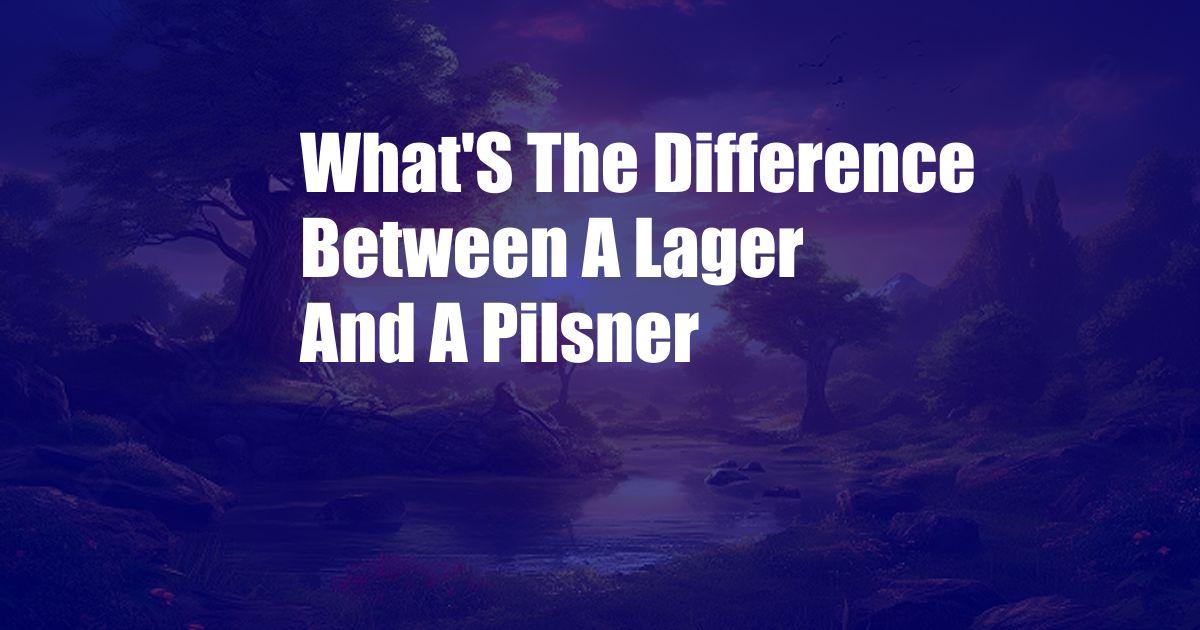
What’s the Difference Between a Lager and a Pilsner?
Cheers! As a beer enthusiast, I’ve discovered the joy of exploring the world through its diverse styles and flavors. Among them, lagers and pilsners stand out as two of the most popular and beloved options. While they share some similarities, there are also subtle yet significant differences that set them apart. Join me on a journey of discovery as we delve into the fascinating world of these two iconic brews.
Lager vs. Pilsner: Understanding the Similarities and Contrasts
When it comes to lagers and pilsners, the lines can sometimes blur due to their intertwined histories. Both lagers and pilsners are bottom-fermented beers, meaning the yeast responsible for their fermentation settles at the bottom of the fermentation vessel. This type of fermentation creates a cleaner and crisper flavor profile.
The defining distinction between a lager and a pilsner lies in their heritage and brewing methods. Lagers, as the name suggests, originated in the colder regions of Central and Eastern Europe, where the use of cool fermentation temperatures (typically around 45 degrees Fahrenheit) prevailed. This process yields a smooth and malty flavor. Pilsners, on the other hand, were born in the Czech town of Pilsen in the 1840s. Pilsners are also bottom-fermented, but at slightly warmer temperatures (around 50-55 degrees Fahrenheit), resulting in a hoppier and more refreshing taste.
Another key difference between lagers and pilsners is the type of malt used in their production. Lagers typically employ a blend of two-row and six-row barley malts, while pilsners rely primarily on two-row barley malt. This variation contributes to the subtle differences in body and flavor between the two styles.
Lager beer typically has a golden to amber color and a slightly sweet malt flavor. It is a popular choice among those who prefer a milder, more balanced beer. Pilsner, on the other hand, is typically straw-colored and has a distinct, crisp, and hoppy flavor. Its bitterness level ranges from moderate to pronounced, making it a favorite among hop enthusiasts.
In the world of lagers, some notable examples include Budweiser, Heineken, and Stella Artois. In the pilsner category, Pilsner Urquell, Urquell, and Bitburger are among the most renowned.
The lager and pilsner landscape is vast and continues to evolve, with new interpretations and variations emerging all the time. From traditional to modern takes, the world of these beers offers something for every palate. Whether you favor the smooth, malty flavor of a lager or the crisp and refreshing hoppiness of a pilsner, there’s a brew out there waiting to delight your taste buds.
So, next time you’re presented with a choice between a lager and a pilsner, embrace the opportunity to explore the subtle nuances and appreciate the unique characteristics of each style. May your beer adventures be filled with endless discoveries and cheers.
FAQs
Q: What’s the origin of the term “lager”?
A: The word “lager” comes from the German word “lagern,” meaning “to store.” Lagers were traditionally stored in cool underground cellars or caves to facilitate slow, cold fermentation.
Q: Can lagers and pilsners be considered craft beers?
A: Yes, many craft breweries produce both lagers and pilsners, using high-quality ingredients and innovative brewing techniques to create unique and flavorful variations.
Q: How do I determine if a beer is a lager or a pilsner?
A: Look at the beer’s color, flavor, and aroma. Lagers typically have a golden to amber color, a malty flavor, and a mild bitterness. Pilsners, on the other hand, have a straw-colored appearance, a crisp and hoppy flavor, and a moderate to pronounced bitterness.
Q: What are some popular food pairings for lagers and pilsners?
A: Lagers pair well with grilled meats, sausages, and cheese. Pilsners complement seafood, spicy dishes, and salads.
Q: How do I store lagers and pilsners properly?
A: Store your lagers and pilsners in a cool, dark place, ideally refrigerating them at a temperature between 40-50 degrees Fahrenheit. Avoid exposing the beer to direct sunlight or high temperatures.
Q: What glassware is best suited for serving lagers and pilsners?
A: For lagers, a traditional beer stein or a pilsner glass is recommended. For pilsners, a tall, tapered pilsner glass enhances the beer’s crispness and aroma.